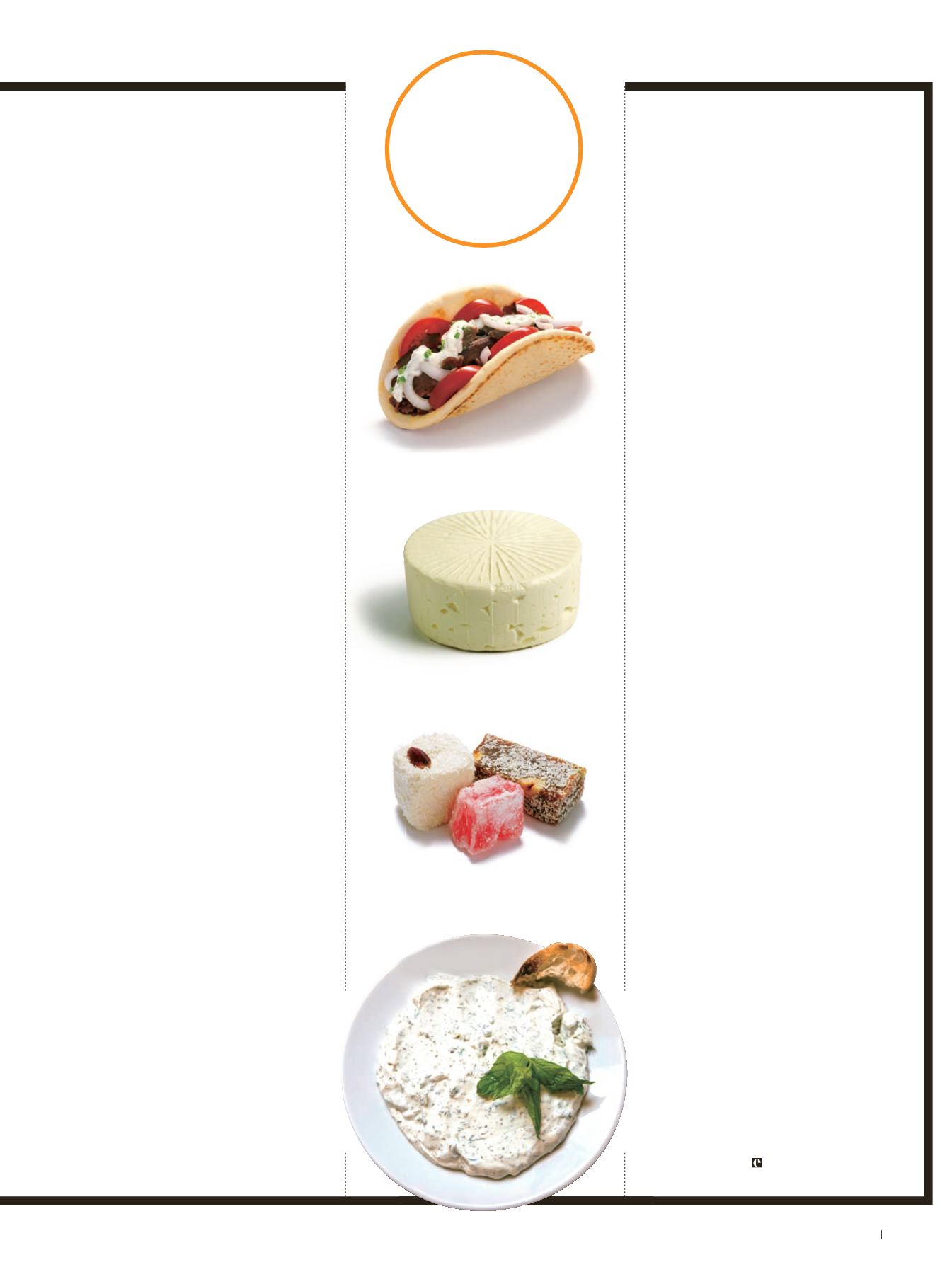
TÜRK KAHVESI
Turkish coffee, or
Türk kahvesi
, refers
not to a particular type of coffee bean
but to a method of preparing unfiltered
coffee by roasting and finely grinding
the beans, then simmering them in a pot
with sugar to offset the bitterness. The
coffee is served in a cup along with the
grounds. Some believe that the coffee
grounds left in the cup after drinking
can be read to tell one’s fortune.
Traditionally when a man wished to
marry a woman, his parents would visit
her parents to ask their permission,
where the intended bride would serve
them Turkish coffee. In preparing the
coffee to the best of her ability, this was
seen as a test of her skills. Sometimes
the girl would prepare the groom’s
coffee with salt instead of sugar to gauge
his temper and patience.
TRY:
Popular among the younger set,
Mandabatmaz uses a traditional
cezve
(a long-
handled metal pot) to prepare its specially
roasted coffee beans.
mandabatmaz.com.tr
MEZE
Similar to appetizers,
meze
refers to
cold starter dishes, served in small
portions. Restaurants that specialize in
meze are called
meyhane
, which also
serve a selection of alcoholic beverages
a n d t r a d i t i o n a l f o o d s . I n o t h e r
r e s t a u r a n t s me z e a r e s e r v e d a s
appetizers; a waiter will bring a large
tray of meze to the table, and each diner
will select one or several plates to place
in the middle of the table to share
alongside bread and
rakı
, an anise-
flavored alcoholic drink. Some of the
more popular meze include
beyaz peynir
(literally “white cheese”), made with
unpasteurized sheep’s, cow’s, or goat’s
milk;
haydari
, a dip made with thick,
strained yogurt mixed with shredded
white cheese, mint, garlic, and salt;
sliced
kavun
, ripe honeydew or galia
melon; and
ezme
, a chili and tomato
paste that includes olive oil, onion,
garlic, lemon, parsley, and green chili
peppers, served with grilled meat.
TRY:
Established over 100 years ago, Tarihi
Cumhuriyet Meyhanesi offers an authentic and
classic meyhane experience with tavern food,
hot and cold meze, and live traditional Turkish
music.
DÖNER
One of Turkey’s most famous foods,
döner kebap
, or döner for short, is known
throughout the world under different
names such as gyro and shawarma — but
they all refer to basically the same thing,
a large slab of meat seasoned with herbs
and spices that is roasted on a vertical
rotisserie. Originally döner was made
with lamb, but today in Istanbul it’s
usually a mixture of lamb and beef, or
beef only. To serve, the meat is sliced
vertically into thin pieces directly off the
spit and wrapped in a
pide
(a thick, pita-
l i k e f l a t b r e a d ) o r
l a v a ş
( a t h i n ,
unleavened flatbread) with salad greens
and tomatoes.
TRY:
For a large concentration of döner
vendors, head to Istiklal Avenue in Taksim.
BAKLAVA
As a successor to the Ottoman culture,
Turkish cuisine boasts a remarkably vast
array of tempting sweets. Perhaps the
country’s most beloved dessert,
baklava
is a
must-eat during your visit, and a box of the
sweet pastry makes the perfect souvenir.
Layers of phyllo are spread with melted
butter and chopped walnuts, pistachios, or
hazelnuts, baked, and then syrup or honey is
poured over it. Though a seemingly simple
dish, an exceptional baklava is marked by a
fresh, buttery scent and a crisp, crackling
sound when you dip your fork into it.
TRY:
Karaköy Güllüo
ğ
lu has been producing
sweets since 1947 and offers a large variety of
baklava that will satisfy both traditionalists and
those looking for something new.
TURKISH DELIGHT
In 1777 Ali Muhittin Hacı Bekir opened a
confectionary shop in Istanbul’s Bahçekapı
district selling
lokums
, soft gel confections
made with water and flour and sweetened
with honey and molasses. In the 19th century
it became fashionable in Europe to exchange
silk-handkerchief-wrapped pieces of the
sweet, sold as “Turkish delight,” as presents
among the upper classes. Modern varieties
include flavors such as cinnamon and mint,
chocolate-covered lokums, and lokums filled
with chopped almonds, pistachios, dates, or
walnuts.
TRY:
Ali Muhiddin Hacı Bekir is the historic
shop run by the same family that claims to
have created the dessert in 1777.
Modern Turkish cuisine is
heavily influenced by Greek,
Middle Eastern, and Central
Asian dishes.
ίତ˾ٙɺЀՉ
ߕ
ʕd̙ۜ
ྒྷՑҎᖳeʕ؇ၾʕԭήਜࣘ
ଣٙፄΥࠬբf
25
enVoyage


